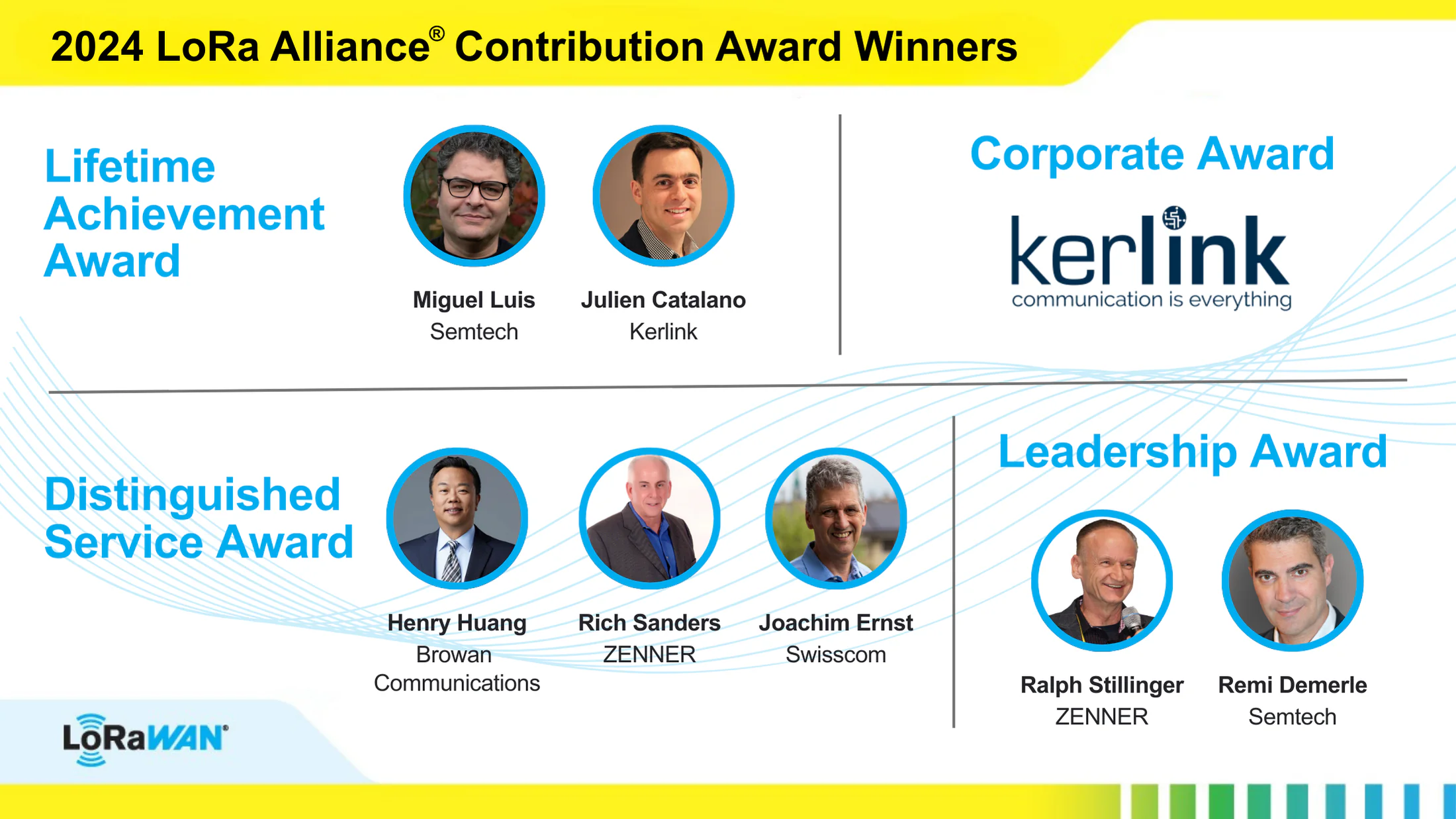Every year, the LoRa Alliance recognizes member companies and individual members for outstanding contributions to the LoRa Alliance. These contributions range from honoring specific campaigns to promote LoRaWAN to sustained contributions over the Alliance’s lifespan. 2024’s winners are no different. They have all made extensive and valuable contributions to the Alliance’s efforts to develop and promote the LoRaWAN standard.
2024 LoRa Alliance Contribution Award Winners
Lifetime Achievement Award
- Julien Catalano, Kerlink
- Miguel Luis, Semtech
Corporate Award
- Kerlink
Leadership Award
- Rémi Demerlé, Semtech
- Ralph Stillinger, ZENNER
Distinguished Service Award
- Joachim Ernst, Swisscom
- Henry Huang, Browan Communications
- Richard Sanders, ZENNER

“The LoRa Alliance is a member-driven organization that relies on support and engagement from our members,” said Alper Yegin, CEO of the LoRa Alliance. “Our success as a global standard is 100% due to the contributions and hard work our members devote to the LoRaWAN ecosystem. It is an honor to recognize those most active within the organization. I sincerely thank all of this year’s winners, and our membership as a whole, for their efforts to develop and raise awareness of LoRaWAN globally.”
The Lifetime Achievement Award recognizes a sustained commitment and significant contributions to the LoRa Alliance over at least three years.
Kerlink’s Catalano has earned this recognition based on his extensive work with the Technical Committee (TC) and the Firmware Update Over the Air (FUOTA) Working Group (WG). A core contributor to, and editor of, the LoRaWAN technical specifications, he currently serves as Vice Chair. Catalano has chaired the FUOTA WG since 2017 and is Kerlink’s alternate member of the Board of Directors. He actively promotes LoRaWAN in various standards bodies and the broader IoT ecosystem to drive awareness and adoption.
Semtech’s Luis executes instrumental work to drive the Certification Committee (CC) and is deeply committed to ensuring the accuracy of all TC and CC specifications. He also participates in five additional WGs. Luis co-authored the original LoRaWAN specification; his knowledge and contributions make him a critical asset to the LoRa Alliance.
The Corporate Award recognizes a LoRa Alliance member company whose employees participate in at least two Committees, WGs, or Task Forces (TFs), maintain a strong voice through active engagement, and impact the broader IoT market.
This year’s Corporate Award winner is Kerlink, a founding member of the LoRa Alliance and permanent Board Member whose leadership has contributed to the Alliance’s success since its inception. Members of Kerlink’s team have actively served on the Board, including as Board Secretary, in the TC, and the FUOTA and Roadmap WGs. Kerlink’s efforts have been critical to guiding the Alliance’s evolution through historical phases and promoting LoRaWAN globally.
The Leadership Award recognizes individual members who have chaired a committee, WG, or TF for at least one year and successfully executed each program’s goals.
Semtech’s Demerlé makes extensive contributions as chair of the Smart Water & Energies WG, raising awareness of LoRaWAN’s use in smart metering in India this year. He led a concerted effort to bring the Alliance to India Smart Utility Week, actively recruiting local members and speaking on global standardization at the event.
ZENNER’s Stillinger is honored for his engagement, leadership, and positive impact on the Alliance and its members. He serves as Chair of the Certification Committee (CC) and Interop WG. Stillinger led initiatives to enhance the certification process and the LoRaWAN Certification Test Tool (LCTT) as part of the CC. He also delivered the first interop event and test plan as part of his contributions to the Interop WG.
The Distinguished Service Award recognizes individual Alliance members who have demonstrated exceptional support for specific initiatives within the Alliance.
Swisscom’s Ernst serves as Chair of the Network Server-Gateway (NS-GW) TF, where he has driven progress for several years, including through contributions to technical specifications of the NS-GW interfaces.
Browan Communications’ Huang currently serves as Vice Chair of the LoRa Alliance Board of Directors, where he has been a staunch advocate for interoperability and standardization. He has also led efforts to strengthen the Alliance’s global reach in new markets and grow awareness in the APAC region. He has been a highly visible LoRaWAN Ambassador, hosting and participating in numerous events and engaging with industry leaders and stakeholders to drive LoRaWAN technology and adoption.
ZENNER’s Sanders currently serves as Treasurer of the LoRa Alliance Board of Directors, ensuring the Alliance’s financial stability and strategic positioning for long-term growth and innovation. He has focused on driving policies and initiatives to strengthen the LoRaWAN ecosystem. He has solicited numerous colleagues to participate in Alliance Committees and WGs, thus enhancing the Alliance’s ability to develop and refine technical standards, certification processes, and compliance frameworks.